South Regional OTFY: Jon & Carol Gould from Florida
What makes them outstanding?
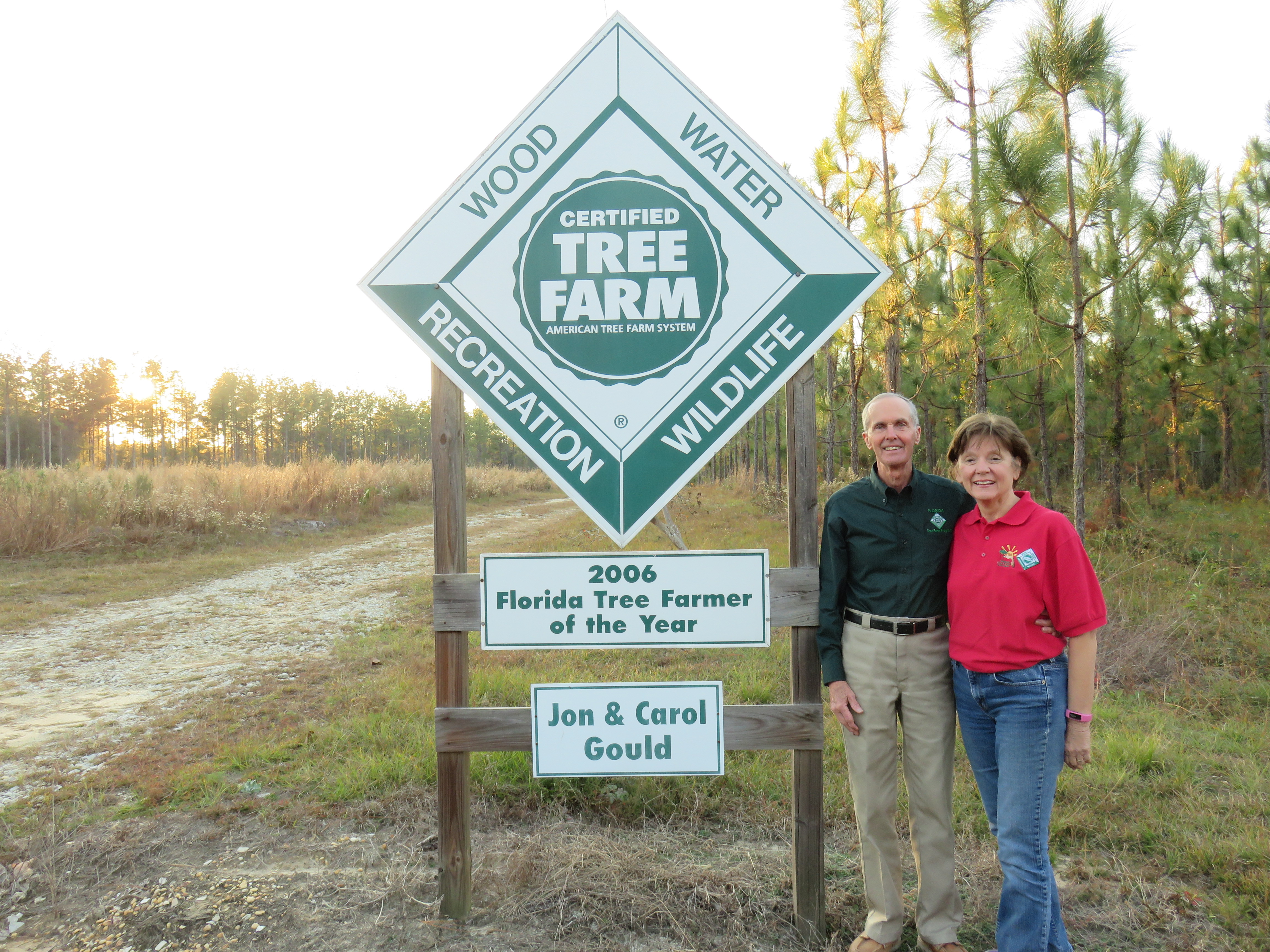 While living five hours from
their Tree Farms, Jon and Carol Gould raised a family and purchased four tracts
of forestland, beginning in 1994. They
have dedicated themselves to actively managing these tracts for timber and
wildlife habitat objectives. Jon has
continued his career as a professional geotechnical engineer and just retired
after 47 years.
While living five hours from
their Tree Farms, Jon and Carol Gould raised a family and purchased four tracts
of forestland, beginning in 1994. They
have dedicated themselves to actively managing these tracts for timber and
wildlife habitat objectives. Jon has
continued his career as a professional geotechnical engineer and just retired
after 47 years.
The Goulds do most of their management and maintenance. Jon is a Florida Certified Prescribed Burner, and they do much of the prescribed burning on their property. They have identified, researched, and documented several historical sites on their property. They protect unique natural and ecologically sensitive sites. The Goulds have also hosted outreach and educational events for many professional and non-professional groups.
They increased their knowledge of sustainable forest management by actively participating in several state and national forestry organizations; studying forestry publications and related literature; and attending workshops, Tree Farm tours, meetings, and conferences. The Goulds have developed close working relationships with state, industry, and private consulting foresters. Jon has served on Florida’s Tree Farm Program State Committee for 11 years. He has been a co-editor of the Florida Land Steward newsletter for 10 years and contributes articles frequently. Jon has written articles for several forestry and wildlife publications, served on forestry panels, and spoken to civic organizations promoting sustainable forestry and Tree Farm. The Goulds are some of the original members of The Longleaf Alliance, and Jon was an invited speaker, representing private landowners, at their 2014 biennial conference.
Tree Farmer story
The story of this Tree Farmer
begins on Merritt Island, Florida. In
1954, when Jon Gould was 11 years old, he helped his father, A. Harvey Gould,
hand plant 10,000 slash pine seedlings on their property. Jon remembers how they carefully laid out
each row and planted each seedling with the same spacing along the rows. The young plantation became one of Florida’s
earliest certified Tree Farms in 1955.
The US Government took by eminent domain all of the Gould property in
the late 1950s and early 1960s when the Merritt Island Launch Annex was expanded
for the US Space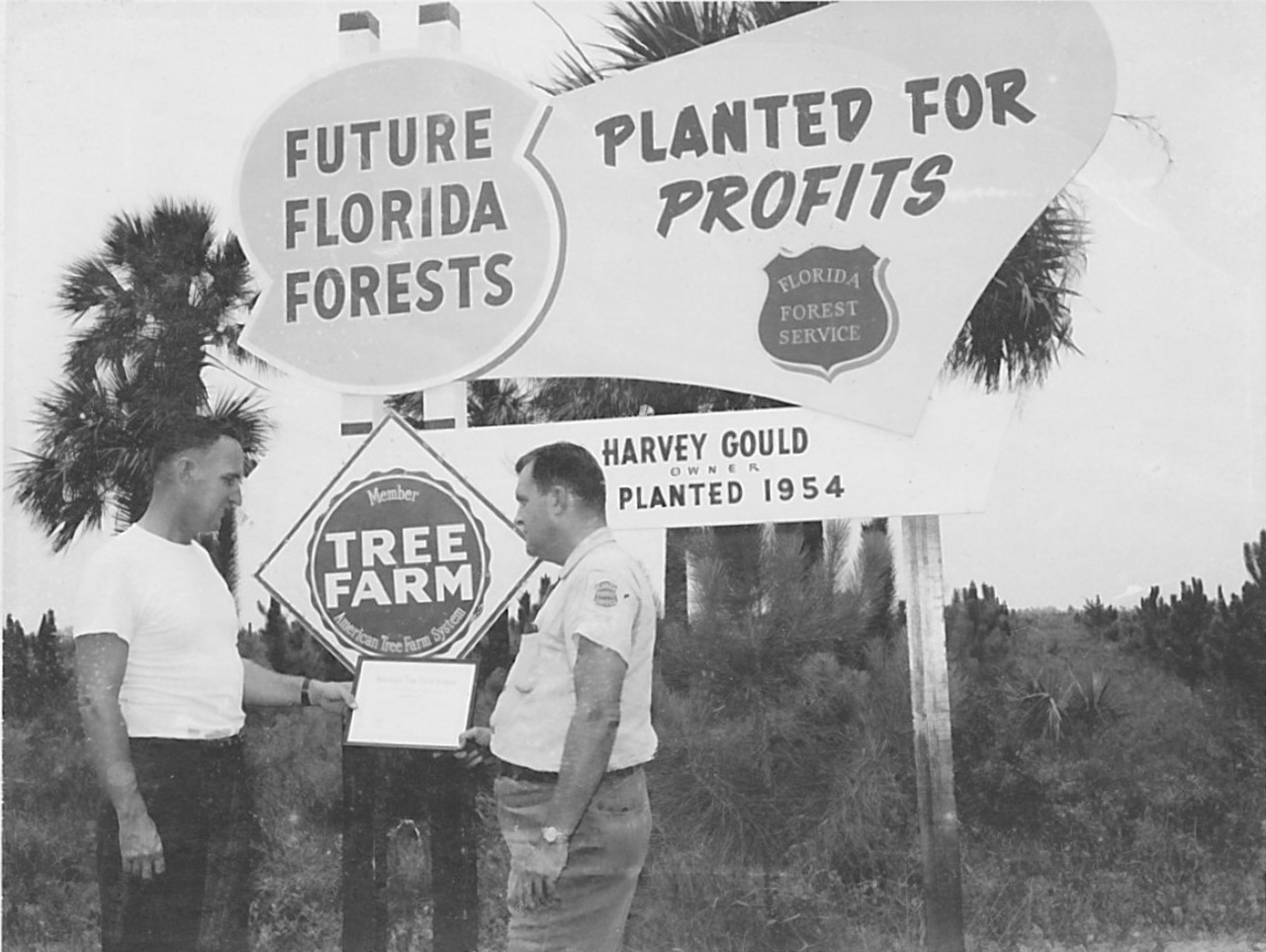 Program. Harvey Gould
then purchased a large tract of timberland in west central Florida and in the
1960s several tracts of timberland in the Florida Panhandle. On the last day before Jon left for a
military tour in Vietnam in 1969, he and his father hand planted pine seedlings
on one of the Panhandle tracts that he and Carol now own. That small stand of pines remains today.
Program. Harvey Gould
then purchased a large tract of timberland in west central Florida and in the
1960s several tracts of timberland in the Florida Panhandle. On the last day before Jon left for a
military tour in Vietnam in 1969, he and his father hand planted pine seedlings
on one of the Panhandle tracts that he and Carol now own. That small stand of pines remains today.
When Jon returned in 1970 after serving as an engineer officer in Vietnam, he planted 50,000 pine seedlings for his father from a tractor-towed open machine planter, and managed the mechanical site preparation of another 35 acres. Afterwards, Jon left to start a 47-year career as a geotechnical engineer that required him to work in most US states. His career and raising a family left little time for his interest in forestry, but Jon and his wife Carol, who knew nothing about forestry when they married, joined the Alabama Forest Owners Association in 1992 and attended local and annual meetings where they learned from talks by forestry and wildlife professionals. They also attended field trips to well managed forestlands, including many Tree Farms. The Goulds joined The Longleaf Alliance in 1996, soon after it was organized, and several other regional and national forestry and wildlife organizations. Through contact with professionals they met while attending meetings and workshops and reading the organizations’ literature, Jon and Carol increased their knowledge of forestry and wildlife management.
The Goulds purchased two of Harvey Gould’s Panhandle tracts, one in 1994 (160 acres) and another (183 acres) in 2003/2010. They also purchased two other nearby timber tracts in 1997 (20 acres) and 2001 (292 acres). These four tracts required significant management activities, as well as new or updated management plans. Each of the tracts are certified as Tree Farms. The various management activities include site preparation, reforestation, prescribed burning, road repairs or new construction, culverts, new fences and gates, mowing, and invasive species control. The Goulds provide much of the manual work and have hired contractors for heavier work, especially that requiring special equipment.
The Goulds joined the Florida Forestry Association in 1996. Jon became a member of the Florida Tree Farm Committee in 2006 and has served actively since, including two years as vice-chairman. He has represented the committee for 10 years as the only private landowner co-editor of the Florida Land Steward newsletter. Jon has served on Florida Forestry Association committees, the Florida Farm Bureau Federation Forestry Advisory Committee, Family Forest Owner Panel at the Sustaining Family Forests 39th Annual SAF/SFRC Spring Symposium, and as a private landowner on the panel of the Private Forestlands Strategies for the Gulf workshop. Jon has been interviewed by the media asking questions about their Tree Farms and sustainable forestry and wildlife. He was an invited speaker at The Longleaf Alliance 2014 biennial conference.
Jon and Carol were selected as the 2006 Florida Outstanding Tree Farmers of the Year. Since then, they have assisted the American Forest Foundation/American Tree Farm System in several capacities. The Goulds are long time financial supporters of the AFF/ATFS and The Longleaf Alliance. They also sponsor a public-school teacher to attend the Florida Forestry Teacher Training in the summer.
The Goulds follow recommended
harvesting practices for their pine stands that include first and second
thinnings and clearcuts. The clearcut
sites are reforested with high quality pine seedlings. Loblolly, slash, and longleaf seedlings are
planted, depending on the species best suited for the site 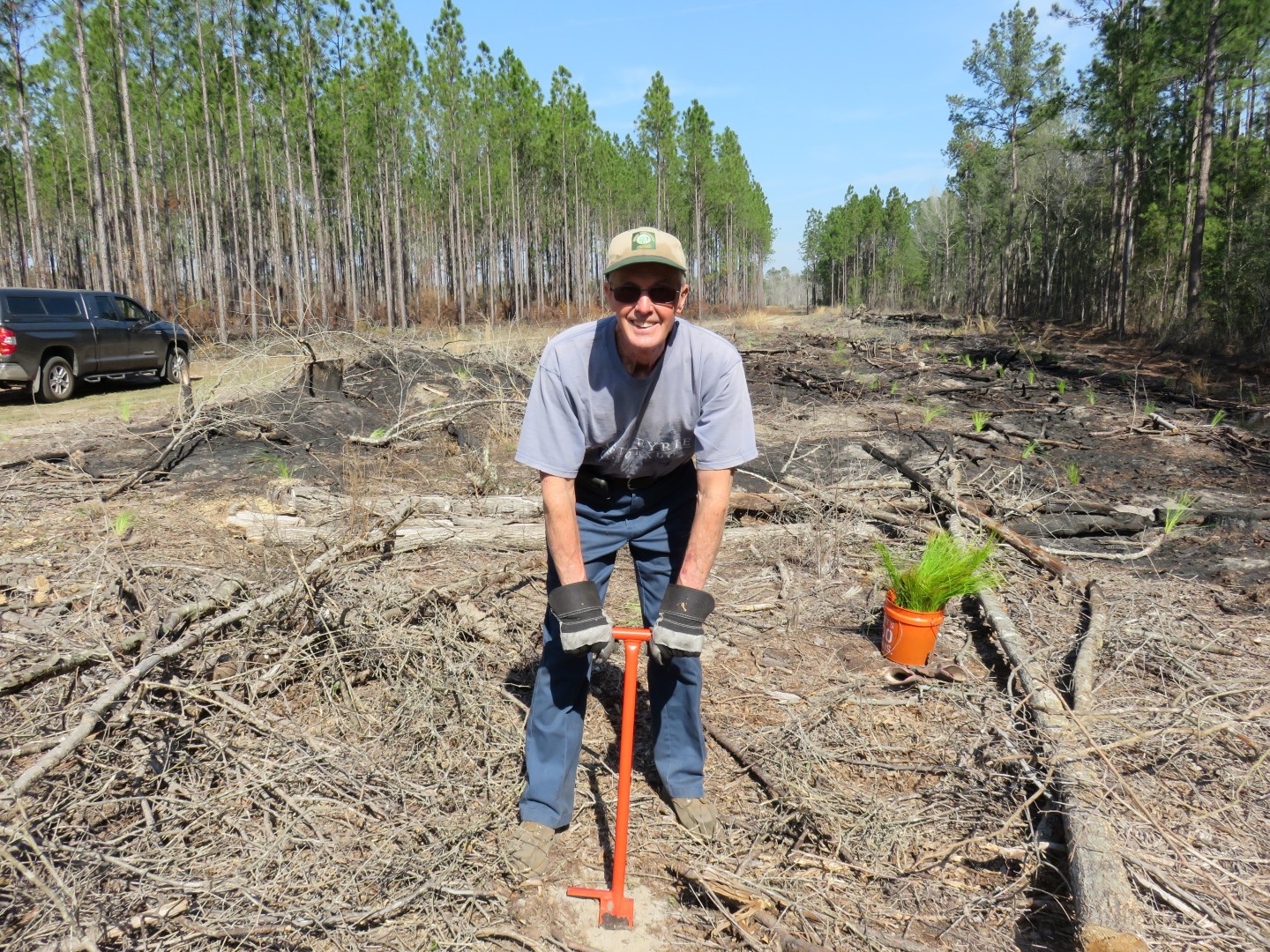 conditions. Since much of their property was originally
covered with virgin longleaf pines, they have re-introduced longleaf on three
of their timber tracts. Since 1997, Jon
and Carol have planted 78 acres of longleaf seedlings on their Tree Farms. The
Goulds have personally hand planted several thousand of these seedlings,
including nearly 1,000 seedlings planted in 2017. Jon is a Florida Certified Prescribed Burner,
so he and Carol conduct most of their smaller prescribed burns. Larger burns are conducted by their
consulting forester. To maintain
property lines, Jon sprays herbicide along several thousand feet of fence line
using a backpack sprayer. He also
regularly sprays patches of cogongrass and Japanese climbing fern, two serious
invasive species on their Tree Farms.
conditions. Since much of their property was originally
covered with virgin longleaf pines, they have re-introduced longleaf on three
of their timber tracts. Since 1997, Jon
and Carol have planted 78 acres of longleaf seedlings on their Tree Farms. The
Goulds have personally hand planted several thousand of these seedlings,
including nearly 1,000 seedlings planted in 2017. Jon is a Florida Certified Prescribed Burner,
so he and Carol conduct most of their smaller prescribed burns. Larger burns are conducted by their
consulting forester. To maintain
property lines, Jon sprays herbicide along several thousand feet of fence line
using a backpack sprayer. He also
regularly sprays patches of cogongrass and Japanese climbing fern, two serious
invasive species on their Tree Farms.
Silviculture Best Management Practices (BMPs) are followed for all harvesting and reforestation practices, as well as various maintenance activities such as road work and fireline discing to protect water quality. BMPs for State Imperiled Wildlife Species are also followed to minimize disturbance to habitat, nesting, and raising young. Gopher tortoises are prevalent on all the property so special care is taken to protect their burrows and the areas around the burrow entrances. Mowing and prescribed burning are not conducted during turkey nesting season. The numerous historical and natural ecologically sensitive sites are documented, monitored, and protected.
When the Goulds purchased their timberland, their three children were either in college or graduated. Marriage and careers followed soon afterwards. Now their children are career focused and raising families and all live out of state. While challenging for them to be involved with the Tree Farm, they usually visit at least once a year. These visits have prompted growing interest from the grandchildren, encouraging Jon and Carol to take legal steps to leave the Tree Farms as a legacy for their children and grandchildren to carry on.
For the following areas describe how the landowner's management addresses it
Wood: The primary goal for this property is income from timber production. Secondary goals include maintaining healthy wildlife populations, enhancing aesthetic beauty, and protecting the natural features and cultural history. Each Tree Farm has a forest management plan that is reviewed frequently and updated every five years.
When purchased, each of the four timber tracts had large areas that had been clearcut, over-thinned, or neglected for years. The clearcut areas were replanted right way. Poor quality natural and planted pine stands were eventually clearcut or thinned. All clearcut sites were site prepared mechanically and/or chemically and replanted with site-appropriate, genetically superior pine seedlings, depending on each site’s soil and moisture conditions. Good growth and healthy trees are produced by planting the best suited pine species on each site and optimal timing for thinning each stand. Harvests and reforestation are conducted under the direction of a private forester by qualified trained loggers and subcontractors following BMPs to protect both water quality and state imperiled wildlife species.
Six species of pines are native to the Gould Tree Farms, including longleaf, loblolly, slash, shortleaf, Choctawhatchee sand, and spruce pines. Over 60 species of trees have been identified, and foresters estimate there may be over twice that many species.
Over the last few years, some
of the sites planted several years ago have been commercially thinned. Most of the planted longleaf and mature
loblolly and slash pine stands are prescribed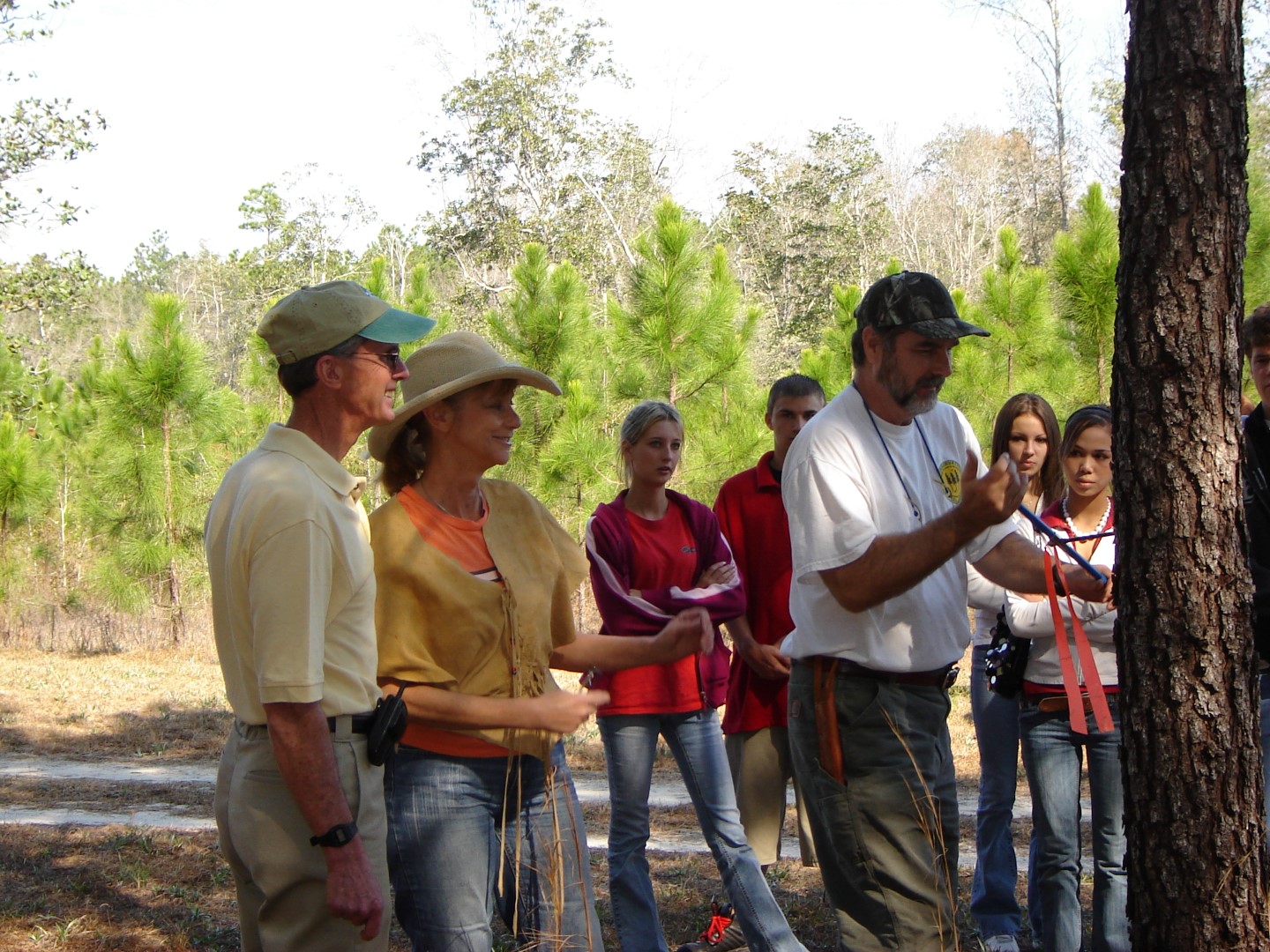 burned frequently to control
hardwood competition and encourage new growth of forbs and natural grasses for
the wildlife. Stands of natural mixed
loblolly and longleaf pines are being converted to longleaf stands. Plans are to convert planted longleaf stands
to open, mature stands through selective thinning. Trees in natural drainage features, SMZs, and
the successional forest are not disturbed.
burned frequently to control
hardwood competition and encourage new growth of forbs and natural grasses for
the wildlife. Stands of natural mixed
loblolly and longleaf pines are being converted to longleaf stands. Plans are to convert planted longleaf stands
to open, mature stands through selective thinning. Trees in natural drainage features, SMZs, and
the successional forest are not disturbed.
Water: The Gould Tree Farms have many natural water resource features, including intermittent streams, ponds, swamps, and springs. One property line is bounded by the Choctawhatchee River. There are also a number of drainage ditches along the unpaved woods roads that assist in the control of rainfall runoff from the roads. Generally, the topography of the property is flat to slightly sloping with a few small areas that are moderately sloping.
The property contains several miles of woods roads. Much of the surface of the less traveled roads is covered with a good stand of grasses. Most of the roads are located on flat topography, so erosion is generally not a problem. Where woods roads cross intermittent streams or areas of rainfall runoff accumulation, either culverts have been installed or cobble size rock has been placed. In localized areas, where the road surface tends to erode during heavy rainfall, water bars have been utilized, along with placement of coarse gravel and cobble size rocks.
Best Management Practices are followed for all silviculture practices, including harvesting, site preparation, planting, chemical applications, fireline construction, prescribed burning, road maintenance, etc. Riparian areas along natural water features are left undisturbed to protect water quality. These riparian areas contain good stands of mixed hardwoods, pines, and cypress trees, as well as native grasses, herbaceous plants, and a duff layer that filter rainfall runoff and minimize soil erosion.
One depression, about 20 feet deep, possibly an old sinkhole, contains a flow of fresh water that comes from an underground spring. In the 51 years the Gould family has owned this property, this spring has never been dry. Relatives of early settlers say that this spring was used as a fresh water source by their relatives and Native Americans as far back as the early 1800s.
Wildlife including threatened and endangered species: The Gould Tree Farms contain an abundance of wildlife, including white-tailed deer, wild turkeys, gray and fox squirrels, dusky pygmy rattlesnakes, eastern diamondback rattlesnakes, gopher tortoises, resident and migratory birds, and many other species. These species are greatly dependent upon quality natural habitat.
Deer and turkey have responded well to periodic thinning and prescribed burning of the pine stands, as this reduces underbrush and encourages the growth of new grasses and herbaceous plants for food and cover. A more open landscape also greatly enhances the many adjacent natural water features and riparian areas, resulting in ideal habitat for rearing young and maintaining healthy deer and turkey populations.
Of course, the more open landscape is also great for the gopher tortoise and many species that use their burrows, such as the eastern indigo snake, gopher frog, and eastern diamondback rattlesnake. The predominantly sandy soils over most of the Tree Farms provide ideal locations for the gopher tortoise to construct their burrows. It has been the Gould’s experience that where there are gopher tortoises there are eastern diamondback rattlesnakes because the two species have a long history of cohabiting. Gopher tortoise populations have increased significantly when timber stands have been clearcut, thinned, or prescribed burned.
Bobwhite quail populations have been in serious decline for years throughout Florida. For the last 15 years or so, no quail have been seen or heard on the Gould Tree Farms. However, after clearing about 35 acres of heavily wooded, dense natural hardwood stands, planting longleaf seedlings, and prescribed burning, small quail coveys have been seen the last two years.
Wildlife Best Management Practices followed on the Gould Tree Farms provide great habitat and protection of wildlife. All hunt club lessees also follow Quality Deer Management Association guidelines.
Recreation and Aesthetics including special sites: The Gould Tree Farms provide recreational
opportunities, including hunting, hiking, fishing, bird watching, observing
wildlife and seasonal wild flowers, and relaxing in the peace and quiet. The Goulds grandchildren enjoy riding the
roads on their bikes. Carol Gould, who
is an artist, enjoys painting wildflowers and landscapes of the property. The 3,100 feet of high bluff along the
Choctawhatchee River and Lassiter Lake offers scenic views year-round. The well managed and maintained property is
aesthetically pleasing for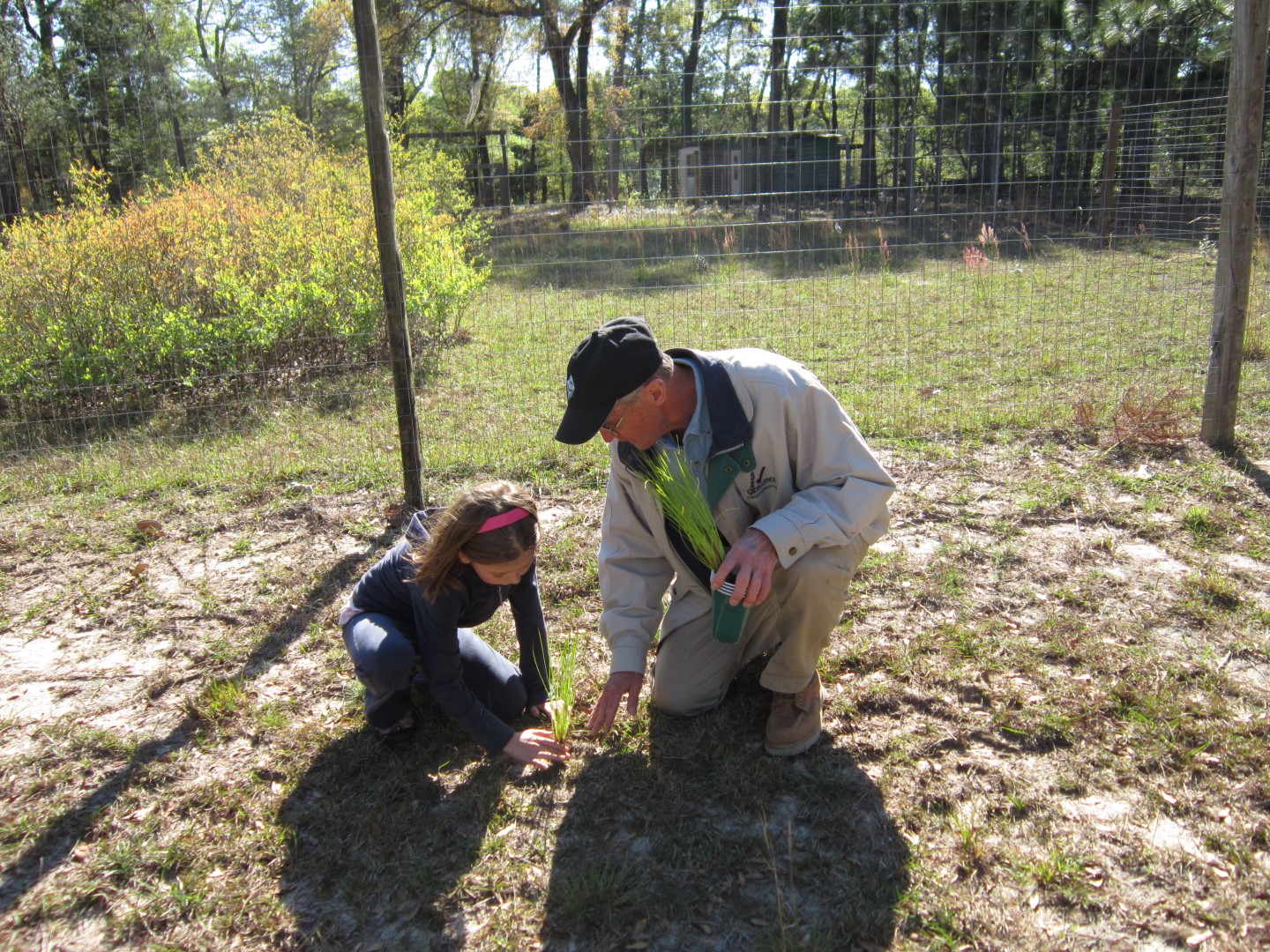 all who visit.
Since the timber tracts are located along public roads, these boundaries
are fenced, gated, well maintained, and each includes a Tree Farm sign. All the property is leased for deer hunting,
except for 18 acres around the houses.
all who visit.
Since the timber tracts are located along public roads, these boundaries
are fenced, gated, well maintained, and each includes a Tree Farm sign. All the property is leased for deer hunting,
except for 18 acres around the houses.
The property contains a number of historical sites, including several old home sites, remnants of a logging tram bed, past turpentine camp (clay Herty cups, metal gutters and barrel bands, broken iron kettle, bricks, etc.), old well casing, WPA camp site, wagon trail/road (early 1800s to mid-1900s), and hand dug well (now filled for safety reasons). The remains of the Lassiter Landing stage coach and public ferry crossing (1830s) is located on Lassiter Lake, which adjoins the river. The Lassiter family (who operated the ferry) home site (1825-?) is nearby. A Native American camp site has also been identified from artifacts collected over the years. Numerous artifacts have also been collected from the Lassiter home site, as well as some of the other old home sites.
Natural special sites include a deep spring-fed depression that always has fresh flowing water. This spring was used by the Lassiters and the Native Americans. Several uncommon pyramid magnolias are located along the river bank and drainage features. At one location, all six major southern pine species can be observed on the property.


